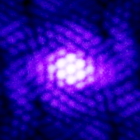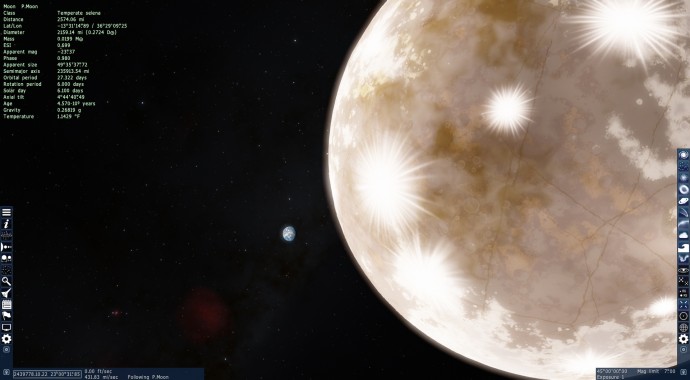|
Science and Astronomy Questions
|
|
| Hornblower | Date: Thursday, 06.10.2016, 03:01 | Message # 796 |
 World Builder
Group: Users
 United States
United States
Messages: 714
Status: Offline
| So obviously, the universal limit for velocity is the speed of light, but is there a universal limit for acceleration?
|
| |
| |
| Watsisname | Date: Thursday, 06.10.2016, 03:36 | Message # 797 |
 Galaxy Architect
Group: Global Moderators
 United States
United States
Messages: 2613
Status: Offline
| Not as far as we know. The largest accelerations we can find are in nuclear physics, with radioactive decay. You might imagine a particle must experience a huge acceleration in order to reach a large fraction of the speed of light over the short distance of the atomic nucleus. 
In fact, let's do an example for fun. Consider the fission of Uranium-235 by neutron capture. This nucleus has a neutron capture cross section of 3 barns for neutrons with an energy of about 104 eV. That's a neutron velocity of about 14km/s. The nucleus' diameter is about 15 femtometers. So for the neutron to be captured within that nucleus, it must undergo an acceleration of at least 1021 m/s2. Pretty impressive!

|
| |
| |
| spacer | Date: Thursday, 06.10.2016, 03:56 | Message # 798 |
 Star Engineer
Group: Users
 Israel
Israel
Messages: 1258
Status: Offline
| does huge acceleration of the particles. so fast as blink of an eye (far far faster)
does it also means the g-force it feels is pretty big?
or g-force is something we only feel as big creatures or machines in free fall or turning fast in the road
"we began as wanderers, and we are wanderers still"
-carl sagan
-space engine photographer
|
| |
| |
| DoctorOfSpace | Date: Thursday, 06.10.2016, 04:00 | Message # 799 |
 Galaxy Architect
Group: Global Moderators
 Pirate
Pirate
Messages: 3600
Status: Offline
| You can calculate approximate g forces on particles, but I don't think it applies could be mistaken though.
Obviously there would be limitations on acceleration for macroscale objects, especially more complex things. Seems to me each object has a different material strength and eventually the forces of acceleration will exceed the objects capability to hold itself together.
Intel Core i7-5820K 4.2GHz 6-Core Processor
G.Skill Ripjaws V Series 32GB (4 x 8GB) DDR4-2400 Memory
EVGA GTX 980 Ti SC 6GB
|
| |
| |
| Watsisname | Date: Thursday, 06.10.2016, 04:04 | Message # 800 |
 Galaxy Architect
Group: Global Moderators
 United States
United States
Messages: 2613
Status: Offline
| Quote spacer (  ) does huge acceleration of the particles. so fast as blink of an eye (far far faster)
does it also means the g-force it feels is pretty big?
Definitely, but I don't think the particles really "feel" it... not that I have actually asked one. 

|
| |
| |
| Hornblower | Date: Thursday, 06.10.2016, 04:08 | Message # 801 |
 World Builder
Group: Users
 United States
United States
Messages: 714
Status: Offline
| So is g-force the only limitation so far to acceleration. We would be able to calculate if there's a limit to g-force (perhaps to avoid creating a black hole) and by extension an actual limit to acceleration.
|
| |
| |
| Watsisname | Date: Thursday, 06.10.2016, 06:03 | Message # 802 |
 Galaxy Architect
Group: Global Moderators
 United States
United States
Messages: 2613
Status: Offline
| A productive avenue might be to consider limits on the ability to accelerate charges. Charges are accelerated by electric field, with acceleration equal to their charge times the field strength divided by their mass. Electrons have a large charge to mass ratio, so they are a good choice for a particle to accelerate. Then the question is how strong can an electric field be?
This is given by the Schwinger limit of ~1018 Volts per meter, above which the classical electric field breaks down and becomes nonlinear.
So, considering electrons subjected to this field strength, they would undergo an acceleration of about 1029 m/s2.
Added: This acceleration is so big that it is hard to contemplate. Here's a way to think about it:
To accelerate the electron to 10% of the speed of light, it would take only 10-22 seconds, and a distance of 2.5 femtometers. This is barely more than the width of a proton! If accelerated over the width of a hydrogen atom (~1 angstrom, or 10-10 meters), it would reach 99.999% of the speed of light!

|
| |
| |
| Hornblower | Date: Thursday, 06.10.2016, 12:00 | Message # 803 |
 World Builder
Group: Users
 United States
United States
Messages: 714
Status: Offline
| Watsisname, thanks, that is really intriguing, but that is for a massive electron. I bet a neutrino could accelerate a lot faster!
|
| |
| |
| Huesudo | Date: Thursday, 06.10.2016, 13:22 | Message # 804 |
|
Observer
Group: Users
 Spain
Spain
Messages: 11
Status: Offline
| Quote spacer (  ) does huge acceleration of the particles. so fast as blink of an eye (far far faster)
does it also means the g-force it feels is pretty big?
or g-force is something we only feel as big creatures or machines in free fall or turning fast in the road
I'm not sure if I can answer your question. G-force IS acceleration. Indeed your eyelids must experience quite a lot when you blink, but they are not very massive and their inertia is very small, so they can cope with high acceleration without any trouble.
|
| |
| |
| Watsisname | Date: Thursday, 06.10.2016, 16:27 | Message # 805 |
 Galaxy Architect
Group: Global Moderators
 United States
United States
Messages: 2613
Status: Offline
| Quote Hornblower (  ) atsisname, thanks, that is really intriguing, but that is for a massive electron. I bet a neutrino could accelerate a lot faster!
That's a good thought -- the neutrino has very low mass -- but there are two problematic things with them. The first is that their masses are very poorly constrained. We know they are not massless since they experience a passage of time (the neutrino oscillation), but it is very difficult to measure what their masses are. The second problem is that they have no electric charge, so they are not accelerated by an electric field. We would have to instead consider interaction through the weak nuclear force. This can be stronger than the electromagnetic interaction, but only over much shorter distances. The nuclear forces are essentially limited to the scale of atomic nuclei.

|
| |
| |
| midtskogen | Date: Thursday, 06.10.2016, 20:58 | Message # 806 |
 Star Engineer
Group: Users
 Norway
Norway
Messages: 1674
Status: Offline
| How does time dilation work for the accellerated particle in this case?
NIL DIFFICILE VOLENTI

|
| |
| |
| Watsisname | Date: Thursday, 06.10.2016, 21:55 | Message # 807 |
 Galaxy Architect
Group: Global Moderators
 United States
United States
Messages: 2613
Status: Offline
| It definitely becomes significant at these kinds of speeds. Here's how we figure it all out. In this case, let's go really crazy and accelerate the electron through this huge electric field strength for a distance of one meter. Recall it only took a few proton widths to reach 10% the speed of light!
To find the time dilation, we need the electron's velocity. To find its velocity, we need its kinetic energy. Actually, that's how I had planned to work this out, but ended up doing it in a different sequence. At any rate:
The relativistic kinetic energy of a particle is not the familiar 1/2mv2 that we learn in Newtonian mechanics. It's a good approximation at low speeds, but fails for large speeds. It incorrectly predicts energy goes to infinity as velocity goes to infinity. The correct relativistic version is:

where gamma is a factor related to its velocity:

We can also define the ratio of v/c (that is, the fraction of the speed of light) as a new number "beta" to make things a bit simpler:

It turns out that gamma also happens to be the time dilation factor. If gamma equals 2, then the time interval in the moving frame is twice as long as in the rest frame. Time passes more slowly by a factor of 2.
In computing the electron velocity, we use the change in its kinetic energy through conversion of electric potential energy by moving through that potential difference. So let's suppose it accelerates (from rest) through the potential difference of 1018 Volts per meter, for a distance of one meter. Its loss in potential energy is its charge times the potential difference, which is 0.2 joules. Which is also how much kinetic energy it gained. 0.2 joules is huge for an electron! In nuclear physics we also commonly define particle energy by the electron volt, which works out simply in this case as 1018 eV. A billion billion electron volts is a lot. 
Now let's relate that to the time dilation factor. If KE=(γ-1)mc2, then γ=KE/(mc2) + 1. The plus one becomes irrelevant here -- mc2 is tiny and 0.2 divided by it is huge. We get 2.44x1012! So time for this electron is passing about two and a half trillion times more slowly than time for us! A single second in its existence is over 77,000 years in the life of the universe!
Now we can go from this dilation factor to its velocity, as a fraction of the speed of light:

Plugging in 2.44x1012 for gamma, we get:
β=0.999999999999999999999999916c
[Holy ****] 

|
| |
| |
| steeljaw354 | Date: Thursday, 06.10.2016, 22:10 | Message # 808 |
 World Builder
Group: Users
 Pirate
Pirate
Messages: 862
Status: Offline
| What if Earth had a moon the mass the same as the one I have showed and had a rotation period of 6 days and looked the same as the one shown?

Edited by steeljaw354 - Thursday, 06.10.2016, 22:28 |
| |
| |
| Tac1017 | Date: Thursday, 06.10.2016, 22:38 | Message # 809 |
 Explorer
Group: Users
 United States
United States
Messages: 167
Status: Offline
| two things:
1: Tides would be gigantic, and catastrophic. This is because of how massive the new moon would be, roughly as massive as earth. The gravitational pull would be greater, and more disaster. It's why i only look around K1-K3 dwarfs for earth-like planets, since the pull is suffice without a moon.
2: it wouldn't really be a moon, but instead a binary planet, since the barycenter would most likely be outside the earth.
The Terra Hunter of the Milky Way!
(By the way, I was born in 2001, NOT 1972 XD)
|
| |
| |
| steeljaw354 | Date: Thursday, 06.10.2016, 22:44 | Message # 810 |
 World Builder
Group: Users
 Pirate
Pirate
Messages: 862
Status: Offline
| Tac1017, I don't think 0.0199 Earths is roughly as massive as the Earth itself.
The Scenario:
The Mars sized object never hits the Earth, and instead that Moon settles into an orbit. It is likely to be eccentric and about the distance from earth to our moon. It keeps it's rotation period and never gets tidal locked
Questions:
What would the system look like in space engine, properly? How long would a day be on Earth? What would intelligent life think of that moon?
|
| |
| |